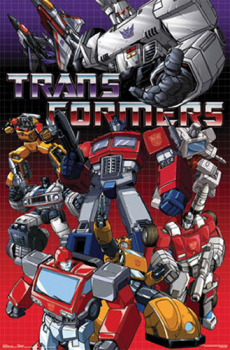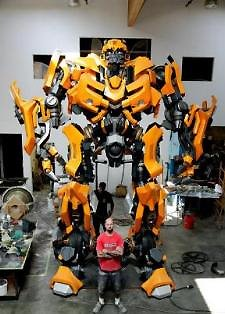Not Yo’ Momma’s Cyborg: Transformers Meet More Than Your Eye
By Anna Beatrice Scott / University of California, Riverside

Gesticulations
Marketing campaigns, meant to enmesh our lives in cycles of desire and incompleteness are compelling experiential screenic devices/entities. They invite tactility through displays of a representation (often) of another corpo-imaginaria consuming a product or using a device in such a way as to trigger our automated response to facial gesture and locomotion styles. The advertisement references the kinesiosphere in order to situate itself as part of our everyday. Though we like to think that we have become immune to these 30 second stories, in fact, they are woven into our movement vocabulary, and often add new gestures to the palettes, sets, and drop down windows.
When the campaign evolves into hundreds of sequential 30 second spots strung together with CGI animation, tweening the breaks in choreography less a fissure erupt through the sutures, our body awareness, i.e. our corpo-reality necessarily materializes as character in the story. We become cybernectic through the manipulation of our gestures; they play back in front of us on the screen, made all the more sensorial by special effects displacing, replacing, and enticing an environment of interaction.
Considering the environment of interaction as a type of social sphere, even when projected or pixelated, gestures emerge as vital components of pre-conceptualized socialization; one driven by a physiological imperative to mobilize the human systems in space and across space, against gravity, but not much else. Our systemic misunderstandings of tone, inflection and bodily movement create the need for story, yet the foot treads marked by habitual action embed stories in the series of interlocking gestures themselves. The kinesiosphere is a way to think about the myriad subtle exchanges we have with other bodies of the external sort. Obviously we share air and water systems, but we share systems of kinemes that are organized into discreet sets across cultures and change as the body itself ages; and now, across mechanics, objects and species.
Trans-Iterations
To talk of CGI animation is in many ways to speak of ILM, Industrial Light and Magic. The developer of most of the code used to digitally enhance action sequences, matte transitions, conduct/create digital animation, ILM has developed a fleet of well-trained and highly skilled animation supervisors responsible for shifting our sense of the possible. In this article, I want to explore not ILM, but the translation/transmorgificaiton of gender and race as dis-created and re-imagined through the Animation Supervisor and the gestures which he chooses to deploy and animate.
The first thing he would tell us, is that much of it is not his choice.
Working in tight formation with an army of production assistants and marketing assistants, master minds like Scott Benza (Star Wars Episode III, Harry Potter & The Sorcerer’s Stone, Pirates of the Caribbean: Dead Man’s Chest, Transformers), have to create a knowable unknown universe exciting enough to sell the product, and surprising enough to leverage as a brand vehicle. Perhaps this article is secretly about branding: gesture, race & gender.
Transformers (2007) is a rip roaring good time. I was struck by how little I groaned, or anyone else in the audience for that matter, at the blatant product placement, and the omnipresence of the Army and DOD. I actually enjoyed the awkward love interest, the greasy chic dream getting a little time, lubricated by the bond of a guy and his ride. Then I realized, duh, this is not odd: it is not that we have become immune to branding, or that we are too wrapped up in a “good story” to notice all the GM vehicles and Pepsico Products, branding has achieved its first sought after goal. We are coursing through an experiential market place like fish in water. The brand is our home. It is our mirror. It is our choreographer. The brand is the story. Without the brand, there is just simulation.
Branding has become our method of ordering, of differentiation of self from group, groups from other groups, us from them, you from me in a way that does not feel so alienating or repulsive. Dancing with the brand, living its dream, provides for cross-species interaction, not to mention death-defying females, wussy boys getting the girl and black men surviving through to the end credits. In Transformers, the brand is absolutely the story. The kinesiosphere of the cyborg as arrived, thanks to decades of Hasbro magic.

Toying with the Kinemes
Hasbro has been around in our homes it seems like forever if you were born after 1952 when their smash hit, Mr. Potato Head®, first hit the shelves. I personally can sing the Transformers© cartoon theme song, which made me treasure every word of Donna Haraway’s “Cyborg Manifesto” when I finally grew up and went to grad school. TRANSFORMERS! ROBOTS IN DISGUISE. TRANSFORMERS! MORE THAN MEETS THE EYE! Lego® on steroids, or a redux of Hasbro’s (in)famous GI Joe® action figure, the Transformer® toy was awesome and battle ready and totally for boys. Totally for pre-soldiers. I always hated the Easy Bake oven. Why couldn’t it transform. BAKING OVEN! ROBOT IN DISGUISE! BAKING OVEN! PIE GETS IN YOUR EYES! But I digress, or head towards the point.
Hasbro, or the Hassenfeld Brothers have been branding playtime for a long time, conquering comic books and Saturday mornings alike in extremely gendered specific ways. That they have leveraged this brand with General Motors and the US Army, into a CGI-driven action film should come as no surprise. Those of us called Gen X-ers when we came out of college into coffee shops and slackerdom (which includes fan boy Scott Benza), are more succintly described as “The Hasbro Nation.” Jammed into predetermined slots of gender reality, our gestures emmanate as much from our diurnal investigations of the humans in our household as they do the animated characters on our screens. And yes, we are also the Atari Nation.
Wait! We are the Tie-In Nation! Yeah, that feels about right.
But branding did not get it right until the 21st century. Now there are parents who don’t remember not being branded.
Big Boy Toys

The use of larger-than life models and CGI animation in the film brings together the childhood fantasy of having the toys actually talk and do their thing for you, without you “animating” them. However, since they are brought to life, they must move in ways that we can recognize as humanoid, less they be too strange to enjoy/emulate. The gestures employed by the robots, we are told through the narration, were culled from the World Wide Web, so in effect, they are mirroring “us,” aping us, for more “effective” communication.
And yet, they are just stereotypes.
Would an alien super culture select that about us? Rhetorical, but as a vehicle for a major toy company, car company, and military regime, this film must trade in base-line gestural patterns in order to maximize audience size and leverage all of the product tie-ins. Gestural sets in this film are very subtle since the animated objects are humanoid/android. We do not have to wonder too much at the distraction of a dancing fairy tale character or cooking rat. Coupled with the color and make of the cars, the viewer is given all of the clues that they need to “race” a robot.
Each robot, like their human counterparts, has an idiosyncratic way of moving through its body to communicate its desire, emotion, and station in the universe. The two most obvious were the yellow Camaro® cum Bumble Bee’s® “talk” through the radio using classic 70s easy rock and Star Trek quotes and Jazz’s® break dancing through any scene. Jazz®, break dance, Pontiac®, get it?


No hoopty, Jazz® is a modified Pontiac Solstice®, but he’s still a “real niggah” as evidenced by his seemingly uncontrollable urge to dance in the face of danger and “break verbs” in a way that reveals his complete inability to properly use Ebonics. The truly mechanized gesture, one that is itself a character in the film, is the transformation from vehicle to upright robot. What type of drop down screening happens in that transition? Does the direction in which the robot flips in order to become bipedal indicate whether it will be friendly or fire? Geek that I am, I have to imagine that the John Frazier and the guys who devoted themselves to building the physical robot for Bumble Bee® thought about these things as they conversed with the animator, Jeff Man about how to tween the rotations and foley in the clicks and whirs of gears shifting into organ-like stasis.
Both characters are voiced as male, as are all the robots. The female is located in the generator/interpretator, immobile, potent, creatrix and destroyer. Ah, and silent. What then, is the difference between the cyborg and the robot? Where is the cyborg on screen? Honestly, the soldiers, the hormonally challenged boy, the car-thieving girl, the code-breaking hot blonde and her fat funky guru are the cyborgs. Even more so, every audience member who’s ever sang that theme song in their pajamas bear the brand of the cybernetic.
Image Credits:
1. Production still from enewsi.com
2. Transformers G1® Frame shot from answers.com
3. Bumble Bee® larger than life from blogspot.com
4. Specs for the Jazz® action figure from blogspot.com
5. “Jazz”® as Pontiac Solstice® from blogspot.com
Please feel free to comment.
the Transformer® toy was awesome and battle ready and totally for boys.
I actually had 3 or 4 Transformers shoved in with my Barbies, My Little Ponies, and Sweet Secrets. The assumption here that the gendering of toys works completely in the way it is intended to work neatens the argument, but is it fair? Are there any toys that aren’t so strongly gendered that aren’t made by some company that has wholesome, ungendered toys as its explicit purpose? I say this as a former toystore employee; almost all toys are gendered, including toys for which there is no explicable reason for the gendering. That being said, children will, often at least before being heavily socialized, refuse to comply. Do we, as adults, have a harder time making these refusals? How likely are most of us to bristle at the sorts of stereotypes that drive movies like Transformers?
Also, tangentially, there was actually just a massive recall of Easy-Bake Ovens because they were ripping off children’s fingers — well, children’s fingers were getting caught in the oven door and burned, but that’s no good, regardless.
Thanks, Carly.
Yes, almost all toys are gendered, but I am interested in the gestures that we acquire as children through play with these objects that later provide, I guess a network for animated stories. I think about the ads that accompany the toys, and they seem to deploy particular ways of moving that are required in order to enjoy the toy. Of course children don’t always comply–I had Tonka trucks that I stole from my brother and would play Amazons with my Barbies(before decapitating them)–but the movie really made me think about the confluence of play, product and politics. All that said, I still want to see it again, because it reminds me of … difficult. does it remind me of interactions shared around the TV set, or in the den watching my brother’s transform their toys or does it remind me to collect, to purchase and show off my wares?
Tough one on the Easy Bake. They are waaaaay fancier than they were when I was little. I guess there is such a thing as too close to reality.
It seems to me that the possibility of resisting the gendering of toy culture by making the “wrong” object choice is beside Anna’s point. The essay focuses on how the gestural vocabulary, the basic grammar of play, is always already gendered, regardless of how creative or resistive individual gamers are. Feminist and queer appropriations of a basically heterosexist paradigm do not in and of themselves transform the paradigm. Witness the popularity of Perez Hilton, whose camp approach to celebutard behavior is utterly and openly dependent upon the very system he claims to satirize. Actually, the whole ethos of Web 2.0 seems precisely to be encourage users to be as creative and even resistive as possible. But this is only possible once, as Anna points out, a generation has branding on the brain, and can hardly think or sing or dance without brands. Parody has become a central premise of the culture industries, and this includes gender parody. I just ordered a ‘Barack Obama is my Homeboy’ t-shirt from a website that also offered a ‘Barack Obama is my Homegirl’ complete with added lipstick, rouge, and blush. There was also a ‘Hilary Clinton is my Homeboy,” etc. The point is to anticipate and provide for every style and gradation of dissent by supplying the communicative tools with which all style and dissent will be expressed or expressible. I think Anna’s essays are providing a very powerful description of this by integrating a performance analysis into media studies, going beyond ideology critique to show how representations literally move us.
I don’t think the work is very good (yours is much better), but have you seen Lash and Lury’s new book, Global Culture Industry? There is a whole section on animation and branding is also a key analytical category for them. Might be useful.
Anna’s comment that Transformers “is a rip roaring good time” got me thinking about “Uncle Stevie’s” column about “dope pop” and the “gotta see it-ness” of Transformers (http://www.ew.com/ew/article/0,,20043515,00.html). In the introductory blurb to his article, King claims “A person should not need Google to keep track of his obsessions.” I think this statement begins to hint at Anna’s point that “every audience member…bear the brand of the cybernetic.” That when we get to the point of the fan-level enculturation we both embody and physically/literally “buy into” and simultaneously know enough about to “virtually” reject the object of obsession (as Tavia gets to above). The discussion of already being branded, and then moving beyond the brand with parody, resonates with discussions of what is the role of “the canon.” It both priviledges a certain perspective; however, it is also the starting point for where we make connections enough to understand one another and then bridge apart in our own rejection/parody.
Hello Tavia!
Thank you very much for the reference. and the praise! I’ve had a great time thinking these issues through here on flow. Watching Transformers popped a few things for me, one of them being that we perform with media texts these days through very intimate sets of gestures and detialed choreographies that we have subscribed to through the consumption of mini-movies like advertisements and cartoons.
I was struck, reading the media package for the film, that the animation supervisor and in fact HIS ENTIRE TEAM, all went back to IL just to work on this film because they were all such huge fans. There as a literal transference of labor power in the CGI industry because so many of these guys got into the business BECAUSE of the film. Follow the link for the photo of Bumblebee to read that article.
It’s long and astounding: as example, the DOD gave carte blanche to the filmmaker Michael Bay to use whatever weapons he wanted. he in turn used actual military personnel as extras in all the military scenes. Big boys with bigger toys. The fandom was oozing all over the set throughout the making of this film. I would venture that it made it more easy to get it done because all of those people had sensorial muscle memory from playing with/invigorating the toy. Just from that alone, performance analysis seemed like the critical step to take.
I am also intrigued by Shelley’s leap into the canon. Kelley, are you saying that the body is being cannonized? or is sourcing external sets of knowledge that is a cannon? I really find the idea of the bodymind as canonnized provocative. Takes me back into Foucault, but with a difference you can almost taste.
thank you to you all for a great conversation!
Un très bon site riche en informations. Merci 1000 fois ! bonne continuation.
qu’est ce que le SEO http://referencersonsitegoogle.wordpress.com référencement google